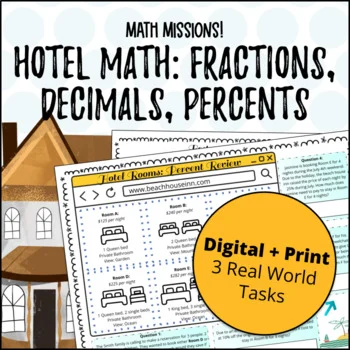Want more ideas and freebies?
Get my free resource library with digital & print activities—plus tips over email.
Join for free resources → by Ping · April 16, 2022
by Ping · April 16, 2022
As a middle school math teacher, I always love showing my students how the math they learn relates to real life. It's an effective way to capture their attention, and it helps them retain the information they're learning.
When we were working on decimals in class, I wanted my students to understand that decimals pop up every day—and that's true! Here are a few situations where your students might find decimal math in daily life.
Get my free resource library with digital & print activities—plus tips over email.
Join for free resources →Let your students imagine they're the manager of a large hotel and need to keep track of occupancy, revenue and profit.
Here's how to use decimals in this situation:
Occupancy Rate. First, calculate your hotel's occupancy rate by dividing the number of occupied rooms by the total number of rooms. For example, if your hotel has 100 total rooms and 30 are occupied, 30 ÷ 100 = 0.3 x 100 = 30% occupancy rate. Every day at noon, the front desk clerk will give you a report on these numbers. Using these numbers, you can make decisions on pricing and availability that will help to maximize occupancy while maintaining an optimal price point for customers.
Daily Room Revenue. Then calculate your daily room revenue by multiplying the average room rate by the number of occupied rooms. Average room rate is found by dividing your total daily room sales (the price you charge guests) by your total number of available rooms (100). For example: $3,000 ÷ 100 = $30 per night average rate x 30 occupied rooms = $900 daily room revenue.
Now, the math discussed above might feel a little dry. I've developed a kid friendly activity inspired by this called Hotel Math.
It has 3 scenarios, covering percents, decimals and fractions:
Percents. Apply discounts and understand revenue from booking rooms. Students will be asked to find things like 25% of 50, etc.
Decimals. Understand potentia
l revenue from different restaurants that want to rent space in the hotel. Select the best applications. Students will be asked to do basic operations with decimals (e.g. multiplication, addition).
Fractions. Understand employee
satisfaction survey results. Students will be asked to solve for things like 2/5 of 50, etc.
Here's what the Percents activity looks like:
The best part? In addition to no-prep PDF and TpT Easel, there's an auto-grading Google Form version of the activity. You can assign it, and students get instant feedback on how they're doing:
Give it a try in your classroom:

$3.99
Looking for a real world application of percents, decimals, and fractions? Do your students love simulation games? This activity has students play the role of a hotel manager, and use their math skills to book hotel rooms, lease restaurant spaces and improve employee satisfaction. Three formats are available in PDF, Google Form, EASEL.
Weddings are expensive. Even at the most affordable venues, you’re looking at a price tag of about $5,000 for a wedding of 100 people. For this reason, you need to be able to calculate your budget and stick to it!
Your wedding budget is the total amount of money that you have available to spend on your wedding. To calculate your budget, add together all of the money that you and your partner have available to spend on the wedding. This might include your own savings or contributions from family members if they’re contributing towards your big day.
If you stay within your budget then you can feel confident that there won’t be any unexpected costs for which you don’t have enough money. If you don’t stay within your budget, then there may be an option for borrowing extra money through an event planner or venue planner if necessary.
I've developed a kid-friendly activity called Wedding Math that puts students in the shoes of an event planner, where they have to guide a couple through deciding on aspects of a wedding, and staying in budget:
Task 1: The Venue
Task 2: The Caterer
Task 3: The Photography & Videography
Task 4: The Wedding Cake
Here's a preview of what Task 4 looks like:
Similar to Hotel Math, Wedding Math is available as a print-and-go PDF as well as on TpT's Easel. It's not yet available in a Google Form. Give it a try:

$3.99
Mastering decimal operations just got a lot more engaging with our Wedding Math project! Designed for fifth and sixth graders, this real-life math project tackles budgeting through the lens of wedding costs, making it a perfect way to integrate decimal operations with relatable scenarios. Students play the role of a wedding coordinator, tasked with using decimals in a practical setting. Aligned with CCSS standards 5.NBT.B.7 and 6.NS.B.3, it features word problems that will make decimal operations fun and memorable for your students.
Calculating profit is an important skill for business owners, especially restaurant owners.
If you own a restaurant, you need to know how much of your revenue is profit.
To do that, you need to calculate your revenue and expenses:
Revenue = Number of orders x average order price
Expenses = Salary + food costs + rent + utilities + other expenses
Profit = Revenue - Expenses
I haven't yet had a chance to develop a dedicated activity for this. But if you love freebies, and want to be the first to hear about future activities, subscribe to my newsletter.

I spent 7 years in the classroom working to make math fun and relevant in middle school, by integrating math, art, and technology. I started Congruent Math to share this all with you.
Get my free resource library with digital & print activities—plus tips over email.
Join for free resources →